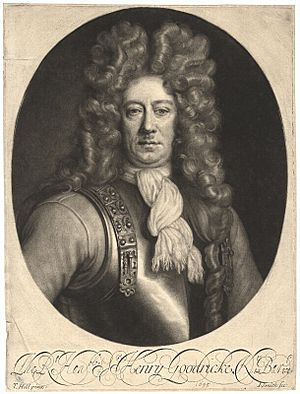Sir Henry Goodricke, 2nd Baronet facts for kids
Sir Henry Goodricke, 2nd Baronet was an important English politician and a diplomat. He was born around 1642 and passed away around 1705. For many years, from 1689 to 1702, he held a significant role as the Lieutenant-General of the Ordnance. This job involved managing military supplies and equipment.
Early Life and Family
Sir Henry Goodricke was the son of Sir John Goodricke, who was the 1st Baronet. A "Baronet" is a special title, like a knight, that can be passed down in a family. When his father died in 1670, Henry became the 2nd Baronet.
He also inherited his family's large estate called Ribston Hall. This beautiful home is located in North Yorkshire, England. In 1674, Sir Henry decided to build a brand new, grand house on the estate.
A Career in Politics
Sir Henry Goodricke was very active in English politics. He was a member of the House of Commons of England, which is a part of the English Parliament. He served there from 1673 to 1679.
After that, he took on a new role as the English ambassador to Spain. An ambassador is like a country's representative in another country. Sir Henry lived and worked in Spain from 1679 until 1683. His job was to help keep good relationships between England and Spain.
When he returned home in 1683, he became a Member of Parliament again. He continued to serve in Parliament until 1705, the year he died. Throughout his long political career, he always represented the area of Boroughbridge.
The Glorious Revolution
In 1688, a major event happened in England called the Glorious Revolution. This was a time when the king was replaced by new rulers, William and Mary. Sir Henry Goodricke played a part in this big change.
He worked with a powerful leader named the Earl of Danby. Sir Henry helped support the revolution in Northern England. Because of his help, the new rulers rewarded him. He was given the important job of Lieutenant-General of the Ordnance. He held this position for many years, until 1702. Sir Henry Goodricke passed away a few years later, in 1705.


